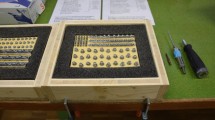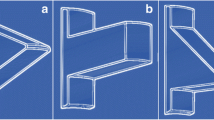Abstract
Objective
We hypothesize that cut screws will deform in a manner that increases the core and outer diameters of the screw hole compared to uncut controls, and effects will be more pronounced in titanium screws.
Materials and methods
We used biomechanical polyurethane foam blocks to simulate cortical bone. We organized four groups of stainless steel and titanium cut and uncut screws. Blocks were fitted with a jig to ensure perpendicular screw insertion. We imaged the blocks using digital mammography and measured them using PACS software. Power analysis determined a power of 0.95 and an alpha error of 0.05.
Results
Highly statistically significant differences in core diameter were found after cutting stainless steel and titanium screws. Cutting stainless steel screws increased core diameter by 0.30 mm (95% CI, 0.16 to 0.45; p < .001). Titanium screws’ core diameter increased by 0.45 mm (95% CI, 0.30 to 0.61; p < .001). No significant differences were found in the outer diameters of stainless steel and titanium screws after cutting.
Conclusion
Titanium and stainless steel screw tracts demonstrated screw core diameter and screw thread pattern deformation after cutting. Titanium screws demonstrated more significant effects.




Similar content being viewed by others
References
Hughes AN, Jordan BA. The mechanical properties of surgical bone screws and some aspects of insertion practice. Injury. 1972;4(1):25–38. https://doi.org/10.1016/s0020-1383(72)80007-x.
Collinge C, Hartigan B, Lautenschlager EP. Effects of surgical errors on small fragment screw fixation. J Orthop Trauma. 2006;20(6):410–3. https://doi.org/10.1097/00005131-200607000-00008.
Foley WL, Frost DE, Tucker MR. The effect of repetitive screw hole use on the retentive strength of pretapped and self-tapped screws. J Oral Maxillofac Surg. 1990;48(3):264–7. https://doi.org/10.1016/0278-2391(90)90391-e.
Ansell RH, Scales JT. A study of some factors which affect the strength of screws and their insertion and holding power in bone. J Biomech. 1968;1(4):279–302. https://doi.org/10.1016/0021-9290(68)90023-7.
ASTM International. ASTM F1839-08: Standard specification for rigid polyurethane foam for use as a standard material for testing orthopaedic devices and instruments. American Society for Testing and Materials; 2021.
ASTM International. ASTM F543-17: Standard specification and test methods for metallic medical bone screws. American Society for Testing and Materials; 2017.
Sawbones. Product Catalog. Pacific Research Laboratories; Vashon, WA: 2021. 2021. http://www.sawbones.com/products/productlist.aspx?111. Accessed January 19, 2021
Elfar J, Menorca RM, Reed JD, Stanbury S. Composite bone models in orthopaedic surgery research and education. J Am Acad Orthop Surg. 2014;22(2):111–20. https://doi.org/10.5435/JAAOS-22-02-111.
Ricci WM, Tornetta P 3rd, Petteys T, Gerlach D, Cartner J, Walker Z, Russell TA. A comparison of screw insertion torque and pullout strength. J Orthop Trauma. 2010;24(6):374–8. https://doi.org/10.1097/BOT.0b013e3181c4a655.
Kim YY, Choi WS, Rhyu KW. Assessment of pedicle screw pullout strength based on various screw designs and bone densities-an ex vivo biomechanical study. Spine J. 2012;12(2):164–8. https://doi.org/10.1016/j.spinee.2012.01.014.
Krenn MH, Piotrowski WP, Penzkofer R, Augat P. Influence of thread design on pedicle screw fixation. J Neurosurg Spine. 2008;9(1):90–5. https://doi.org/10.3171/SPI/2008/9/7/090.
Douglass NP, Behn AW, Safran MR. Cyclic and load to failure properties of all-suture anchors in synthetic acetabular and glenoid cancellous bone. Arthroscopy. 2017;33(5):977–985.e5. https://doi.org/10.1016/j.arthro.2016.11.022.
Selenia H. Hologic selenia dimensions mammography system data sheet. Hologic Inc.; 2016.
Fleiss JL. Statistical methods for rates and proportions. 2nd ed. New York: John Wiley; 1981.
Kaur M, Singh K. Review on titanium and titanium based alloys as biomaterials for orthopaedic applications. Mater Sci Eng C Mater Biol Appl. 2019;102:844–62. https://doi.org/10.1016/j.msec.2019.04.064.
Hasegawa T, Yamano K, Hamada Y, Miyamori T. Intraoperative screw trimming in direct screw fixation of the odontoid process fracture – technical note. Acta Neurochirurgica. 1992;115:60–1. https://doi.org/10.1007/BF01400592.
Rismani S, Allan G, Chung V, Tam R, Wilson DR, Van der Loos HFM. Applying the biodesign innovation process: addressing the inadequate supply of surgical screws in the developing world. IEEE Healthcare Innovation Conference (HIC), Seattle, WA, USA. 2014;2014:259–62. https://doi.org/10.1109/HIC.2014.7038924.
Livingston KS, Edwards EA, Griffin M, MacKenzie JD, Zapala MA. Use of digital tomosynthesis in assessing accurate medial epicondyle fracture displacement as compared with conventional radiography and computed tomography. J Pediatr Orthop. 2021;41(10):e877–83. https://doi.org/10.1097/BPO.0000000000001917.
Ha AS, Lee AY, Hippe DS, Chou SH, Chew FS. Digital tomosynthesis to evaluate fracture healing: prospective comparison with radiography and CT. AJR Am J Roentgenol. 2015;205(1):136–41. https://doi.org/10.2214/AJR.14.13833.
Guo S, Tang H, Zhou Y, Huang Y, Shao H, Yang D. Accuracy of digital tomosynthesis with metal artifact reduction for detecting osteointegration in cementless hip arthroplasty. J Arthroplasty. 2018 y;33(5):1579-1587. https://doi.org/10.1016/j.arth.2017.12.037.
Munk B, Frøkjaer J, Larsen CF, Johannsen HG, Rasmussen LL, Edal A, Rasmussen LD. Diagnosis of scaphoid fractures. A prospective multicenter study of 1,052 patients with 160 fractures. Acta Orthop Scand. 1995;66(4):359–60. https://doi.org/10.3109/17453679508995561.
Funding
The authors utilized no outside sources of funding in the preparation or execution of this research. The senior author utilized personal funds to acquire all materials and research literature. The Simulation Center at Naval Medical Center Portsmouth loaned their Synthes® 3.5 mm small fragment locking tray and donated 26 3.5 mm stainless steel cortical screws and 20 3.5 mm titanium cortical screws for this study from their surplus stock.
Author information
Authors and Affiliations
Corresponding author
Ethics declarations
Ethical approval
This research did not involve human or animal subjects and did not require Institutional Review Board approval.
Additional information
Publisher’s note
Springer Nature remains neutral with regard to jurisdictional claims in published maps and institutional affiliations.
Rights and permissions
About this article
Cite this article
Major, J.W., Ernst, A.J., Kallevang, J.K. et al. A radiologic determination of the different screw cutting patterns in cut and uncut orthopedic cortical screws using a novel imaging technique. Skeletal Radiol 52, 2461–2467 (2023). https://doi.org/10.1007/s00256-023-04368-7
Received:
Revised:
Accepted:
Published:
Issue Date:
DOI: https://doi.org/10.1007/s00256-023-04368-7




